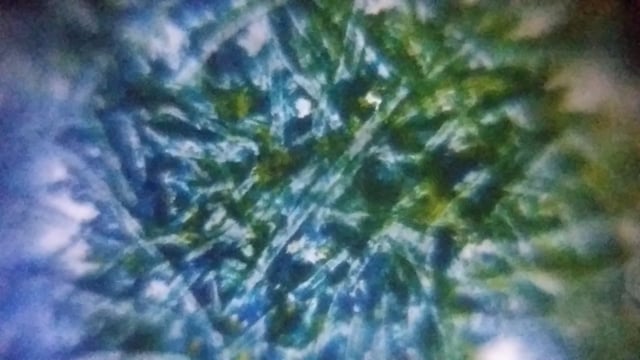Micropainting- Tiny Watercolor Explorations
 Feb 19, 2018 • 7:26 PM UTC
Feb 19, 2018 • 7:26 PM UTC United States
United States 140x Magnification
140x Magnification Non-Living
Non-Living
RebeccaKonte
Scientific artist, using art as a tool for scientific storytelling. http://www.rebeccakonte.com/
27posts
25comments
22locations

Over the weekend, I thought it’d be interesting to try to translate what I do as an artist into a Foldscope experiment. I gathered the materials necessary for traditional watercolor painting & prepared to make some art on a microscopic scale.

Materials: watercolor paper, watercolor pencils (similar to colored pencils, but water soluble– forming paint when water is added), and my DIK.
On a blank glass slide from my DIK, I mounted a small piece of paper with the pencil sketched on. I tried a couple different sketching methods, very light and very heavy, for comparison.
On a blank glass slide from my DIK, I mounted a small piece of paper with the pencil sketched on. I tried a couple different sketching methods, very light and very heavy, for comparison.

lightly colored

densely colored
Slide Preparation: for each slide the sketch is mounted beneath a glass cover slip, but because I knew I wanted to add water to create a “painting”– I also included an extra little piece of paper on one side to create a wedge. I then taped the cover slip to the slide on the sides and bottom. This was intended to create a little pocket to record as I add water & my painting to comes to life.
Initially, I worried the paper may be too dense to let light through, but was surprised how well it imaged! Here are some of my favorite views, I especially liked seeing the the stark comparison between the coloring techniques.
Slide Preparation: for each slide the sketch is mounted beneath a glass cover slip, but because I knew I wanted to add water to create a “painting”– I also included an extra little piece of paper on one side to create a wedge. I then taped the cover slip to the slide on the sides and bottom. This was intended to create a little pocket to record as I add water & my painting to comes to life.
Initially, I worried the paper may be too dense to let light through, but was surprised how well it imaged! Here are some of my favorite views, I especially liked seeing the the stark comparison between the coloring techniques.










Next, I attempted to add water to make it a true “painting” and record the moment of saturation through video. This part I feel was less successful, but a moment to learn from! With I pipette I simply added a couple drops of water to the open end of the slide, and recorded as it trickled down to my sample.
Also, an audio disclaimer– I was watching Lord of the Rings during these experiments, so please excuse the wildly dramatic music and orc-ish voices!
Also, an audio disclaimer– I was watching Lord of the Rings during these experiments, so please excuse the wildly dramatic music and orc-ish voices!
I noticed as soon as water was added the focus was immediately lost. I imagine this is because the water filled a plane of space closer to the lens. In this next video I took some time to pan through the different planes & focus on the different levels of particles floating in the mixture.
Excited to continue to explore ways to make art at a very small scale… I find the concept itself very interesting. It was fun to repurpose a traditional medium with less than traditional methods.
Until next time!
-Rebecca
Until next time!
-Rebecca
Sign in to commentNobody has commented yet... Share your thoughts with the author and start the discussion!

 0 Applause
0 Applause 0 Comments
0 Comments

















